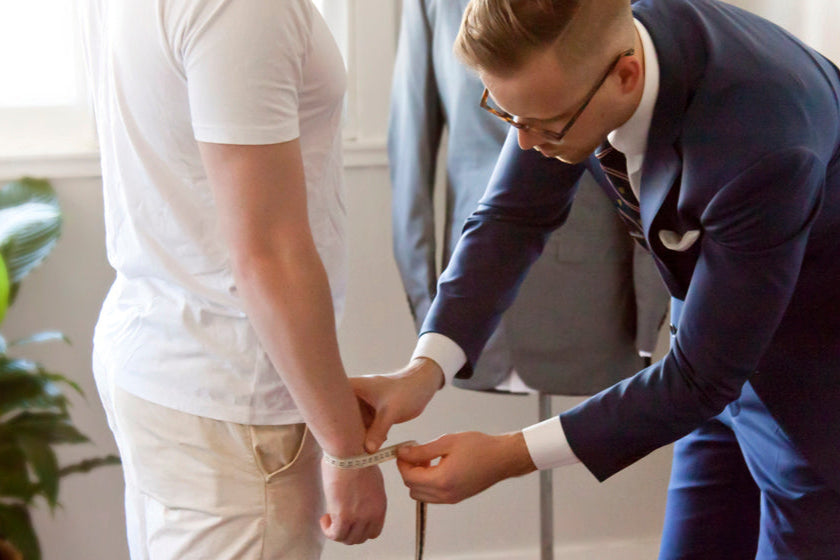
The Ultimate Guide to Finding the right Bespoke Suit
Why Invest in a Bespoke Suit?
A bespoke suit is more than just clothing—it’s a statement of style, confidence, and craftsmanship. Unlike off-the-rack options, a custom-tailored suit is designed specifically for your measurements, preferences, and lifestyle. Whether you're dressing for a business meeting, wedding, or formal event, the right bespoke suit ensures a perfect fit and a timeless look.
But with so many fabric choices, styles, and fit options, how do you choose the perfect one? This guide will help you navigate the bespoke tailoring process so you can make the best decision for your next suit.
Step 1: Understanding the Bespoke Process
The bespoke tailoring process is a collaborative experience between you and your tailor. Here’s what to expect when designing a custom suit:
-
Initial Consultation – Discuss your needs, preferred style, and budget with a professional tailor.
-
Fabric Selection – Choose from high-quality materials like wool, linen, or cashmere.
-
Measurements & Fittings – Precise body measurements are taken for a perfect fit.
-
Multiple Fittings – Adjustments are made to ensure the suit enhances your posture and movement.
-
Final Stitching – The suit is handcrafted to perfection, ensuring durability and comfort.
Suit Society Tip:
For long-lasting quality, ask about floating canvas construction—this technique allows the suit to mold to your body over time, providing a more natural drape.
Step 2: Choosing the Right Fabric for Your Lifestyle
Fabric selection is crucial for both comfort and aesthetics. Each fabric type has unique properties that affect breathability, durability, and style.
|
Fabric Type |
Best For |
Key Benefits |
|
Wool |
All seasons |
Breathable, wrinkle-resistant |
|
Linen |
Summer & casual wear |
Lightweight, stylishly relaxed |
|
Cashmere |
Luxury & formal wear |
Soft, premium feel |
|
Tweed |
Winter & business casual |
Warm, textured look |
Suit Society Recommendation:
For versatility, a super 120s or 150s wool suit is an excellent choice—it balances softness, durability, and breathability for year-round wear.
Step 3: Finding Your Perfect Suit Fit
A well-fitted suit enhances your presence and comfort. Here are the key elements to look for:
-
Shoulders: The jacket's shoulder seam should align perfectly with your natural shoulder.
-
Chest & Waist: The suit should fit snugly but not be restrictive—allowing ease of movement.
-
Jacket Length: Ideally, the jacket should cover half of your seat when standing.
-
Sleeve & Trouser Length: A quarter-inch of shirt cuff should be visible from the jacket sleeve, and trousers should have a slight break at the shoe.
Common Fit Mistakes to Avoid:
-
Too-tight jackets that restrict movement
-
Baggy suits that lose structure and shape
-
Sleeves or trousers that are either too long or too short
Step 4: Customizing Your Suit (Lapels, Buttons & Details)
Personalization is what makes a bespoke suit stand out. Here are the key elements to customize:
Lapels:
-
Notch Lapel – A classic and versatile choice for business suits.
-
Peak Lapel – Bold and structured, ideal for formal wear.
-
Shawl Lapel – Sleek and modern, commonly used for tuxedos.
Buttons:
-
Single-breasted (2 or 3 buttons) – A timeless, go-to style for most occasions.
-
Double-breasted (6 buttons) – An elegant and sophisticated option for a powerful look.
Pockets & Stitching:
-
Choose between flap pockets, welt pockets, or patch pockets based on formality.
-
Opt for hand-stitched details to elevate craftsmanship and durability.
Suit Society Tip:
For an extra touch of elegance, monogram your initials inside the jacket lining.
Step 5: Selecting the Right Suit Color & Pattern
The right color depends on your wardrobe, occasion, and skin tone.
Classic Suit Colors for Every Man:
-
Navy Blue – Perfect for business and formal events.
-
Charcoal Grey – A versatile color suitable for various occasions.
-
Black – The best option for formal evening wear and tuxedos.
For a Bolder Look:
Try subtle patterns like windowpane, pinstripes, or herringbone to add personality while maintaining elegance.
Expert Insight:
Dark colors create a slimming effect, while lighter shades feel more relaxed and casual.
Step 6: Styling Your Bespoke Suit
The final touches make all the difference. To complete your look:
-
Shoes: Oxfords for formal settings, loafers for a relaxed yet stylish appeal.
-
Shirt & Tie Combo: Match patterns carefully; a plain shirt pairs well with bold suits.
-
Accessories: Add a pocket square or tie clip for a refined touch.
Avoid:
-
Mismatched belt and shoe colors
-
Over-accessorizing—keep it simple and elegant
Conclusion: Elevate Your Wardrobe with a Bespoke Suit
A bespoke suit is an investment in quality, style, and confidence. By selecting the right fabric, fit, and details, you create a suit that is uniquely yours and built to last.
Ready to upgrade your style? Book a fitting with Suit Society today and experience true craftsmanship.



